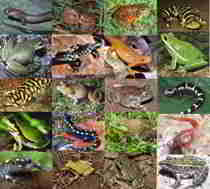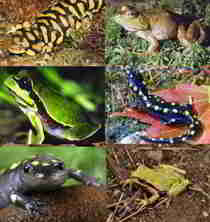
North Carolina Symbols
North Carolina State Salamander
Marbled Salamander
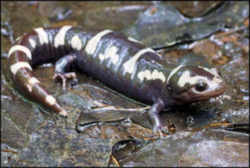
(Ambystoma opacum)
Adopted on June 26, 2013..
The marbled salamander, (Ambystoma opacum,) became the official state salamander of the State or North Carolina when Governor Pat McCrory signed mega-symbol House Bill No. 830 on June 26, 2013.
North Carolina Salamander: Marbled Salamander
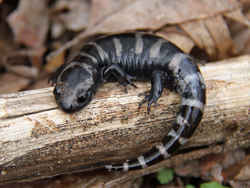
The marbled salamander, (Ambystoma opacum,) is a species of mole salamander found in the eastern United States. Marbled salamanders reach a length of 4 to 5 inches (10 to 12.7 cm), head and body. They have smooth, dark gray to black skin, or even deep purple above with a gray belly. Light silver to white markings are on their back. Marbled salamanders have a stocky body with a short, broad head, and a relatively short tail for a salamander - their tail is 40% of their total length. They also have short legs with four toes on their forelegs and five toes on their hind legs.
Characteristics
The marbled salamander is three to five inches long. It has a black body with white or silvery-gray markings. The female has gray markings and the male has white markings. It has 11-12 costal grooves (vertical grooves).
Range
Marbled salamanders are widespread across the eastern half of the United States and throughout East Texas from Red River south to the Gulf of Mexico
Habitat
This salamander is found in deciduous forests of the piedmont and coastal plain. It may be abundant in floodplain forests, but also occurs in upland forests where appropriate breeding sites are found. This species is found in drier situations than are suitable for most species of Ambystoma.
Diet
The aquatic larvae feed on macrozooplankton, insects, insect larvae, isopods, snails, worms, and other invertebrates. Because this salamander is often the first to hatch after the inundation of the pool, it is a major predator on other amphibian eggs and larvae. Adults feed on small invertebrates and often hunt at night.
Life Cycle
The marbled salamander breeds from September to October in the northern part of its range and from October to December in the southern part of its
range. The marbled salamander mates and lays its eggs on land. The female lays 50-200 eggs, one at a time, in a depression under a log or in a clump
of vegetation that will fill with water when it rains.
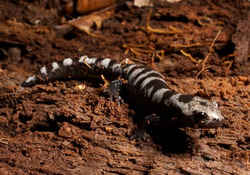 The
female usually curls her body around the eggs to keep them moist and waits for rain to fill the depression. The larvae hatch a few days after being
covered by water. If there is not enough autumn and winter rain, the larvae may not hatch until spring! The larvae will change into salamanders in
about three to six months.
The
female usually curls her body around the eggs to keep them moist and waits for rain to fill the depression. The larvae hatch a few days after being
covered by water. If there is not enough autumn and winter rain, the larvae may not hatch until spring! The larvae will change into salamanders in
about three to six months.
Behavior
Except for during breeding season, marbled salamanders are solitary creatures.
NORTH CAROLINA HOUSE BILL 830
The marbled salamander became the official state salamander of the State or North Carolina when Governor Pat McCrory signed mega-symbol House Bill No. 830 on June 26, 2013.
AN ACT to adopt an official state fossil, frog, Salamander, marsupial, folk art, and art medium.
Whereas, some of North Carolina's official State symbols have been suggested by the State's school children after they have had history, science, social
studies, or geography lessons related to North Carolina; and
Whereas, this year some of the suggestions range from the adoption of an official fossil to an official frog; and
Whereas, the State of North Carolina has a number of unique official symbols but does not have an official fossil, frog, salamander, marsupial, folk
art, or art medium; and
Whereas, the megalodon shark is an extinct shark species that lived over 1.5 million years ago; and
Whereas, the megalodon shark may have reached over 40 feet in length and weighed up to 100 tons; and
Whereas, the megalodon shark had serrated, heart-shaped teeth that may have grown to over seven inches in length; and
Whereas, fossilized teeth of the megalodon shark have been found in North Carolina and throughout the world; and
Whereas, North Carolina and the Southeast region of the United States lead the world in amphibian diversity; and
Whereas, the pine barrens tree frog can be found in the Sandhills and Coastal Plain regions of North Carolina; and
Whereas, the pine barrens tree frog has been considered one of the most striking and beautiful frogs in the Southeast region of the United States;
and
Whereas, the pine barrens tree frog by name reflects one of North Carolina's signature trees and ecosystems that have been a vital part of the State's
economic, cultural, and natural history since colonial times; and
Whereas, North Carolina also leads the nation and world in salamander diversity, most notably in our Appalachian Mountains; and
Whereas, the marbled salamander is found throughout the State and is unique in that it is a charismatic, striking, chunky-bodied, fossorial amphibian,
of which no two are exactly alike in color pattern; and
Whereas, according the North Carolina Wildlife Commission's 2005 North Carolina Wildlife Action Plan, the pine barrens tree frog and the marbled salamander
have been identified as priority species for population monitoring and conservation in North Carolina; and
Whereas, the Virginia opossum is native to North Carolina and is the only marsupial found in North America; the female carries its underdeveloped young
in a pouch until they are capable of living independently, similar to a kangaroo; and
Whereas, the Virginia opossum is one of the oldest and most primitive species of mammal found in North America; and
Whereas, the Virginia opossum is about the size of a large house cat with a triangular head; a long pointed nose; dark eyes; a long, scaly, prehensile
tail; and short, black, leathery ears; and
Whereas, the Virginia opossum is nocturnal and lives in a wide variety of habitats, including deciduous forests, open woods, and farmland but prefers
wet areas such as marshes, swamps, and streams; and
Whereas, at age 65, Vollis Simpson, a self-taught folk artist, began making giant windmills known as "whirligigs" at his home in Wilson,
North Carolina; and
Whereas, Mr. Simpson's whirligigs have been exhibited at the North Carolina Museum of Art in Raleigh, the High Museum of Art in Atlanta, Georgia, and
the Visionary Art Museum in Baltimore, Maryland, and at other locations, including New York, California, Canada, and England; and
Whereas, Mr. Simpson and details of his artwork have been featured in many national magazines and in several books; and
Whereas, the City of Wilson is developing the Vollis Simpson Whirligig Park to display a large collection of these whirligigs in historic downtown,
which will be a one-of-a-kind destination for visitors; and
Whereas, North Carolina's clay-rich soil has contributed to the State's pottery heritage; and
Whereas, the use of clay has grown from the State's early Native Americans making mostly utilitarian wares and European settlers continuing the traditions
of their ancestors to today's potters designing pottery with utilitarian and aesthetic elements; and
Whereas, the pottery tradition continues to thrive in North Carolina, especially in the Seagrove area, which includes parts of Chatham, Lee, Moore,
Montgomery, and Randolph Counties; and
Whereas, clay continues to be an important art medium contributing to the State's cultural, social, and economic prosperity; Now, therefore,
The General Assembly of North Carolina enacts:
SECTION 1. Chapter 145 of the General Statutes is amended by adding the following new sections to read:
§ 145-41. State fossil.
The fossilized teeth of the megalodon shark is adopted as the official fossil of the State of North Carolina.
§sect; 145-42. State frog.
The pine barrens tree frog (Hyla andersonii) is adopted as the official frog of the State of North Carolina.
§ 145-43. State salamander.
The marbled salamander (Ambystoma opacum) is adopted as the official salamander of the State of North Carolina.
§ 145-44. State marsupial.
The Virginia opossum (Didelphis virginiana) is adopted as the official marsupial of the State of North Carolina.
§ 145-45. State folk art.
The whirligigs created by Vollis Simpson are adopted as the official folk art of the State of North Carolina.
§ 145-46. State art medium.
Clay is adopted as the official art medium of the State of North Carolina."
SECTION 2. This act is effective when it becomes law.
In the General Assembly read three times and ratified this the 20th day of June, 2013.
s/ Philip E. Berger
President Pro Tempore of the Senate
s/ Thom Tillis
Speaker of the House of Representatives
s/ Pat McCrory
Governor
Approved 4:24 p.m. this 26th day of June, 2013
North Carolina General Statutes
The law designating the pine barrens tree frog as the official North Carolina state frog is Section 145-43 (State salamander) of the North Carolina General Statutes Chapter 145 (State Symbols and Other Official Adoptions) Section 145-43
Chapter 145 State Symbols and Other Official Adoptions.
§ 145-43. State salamander.
The marbled salamander (Ambystoma opacum) is adopted as the official salamander of the State of North Carolina. (2013-189, s. 1.)
Taxonomic Hierarchy: Marbled Salamander
Kingdom: Animalia
Phylum: Chordata
Class: Lissamphibia
Order: Caudata
Family: Ambystomatidae
Genus: Ambystoma
Species: A. opacum
